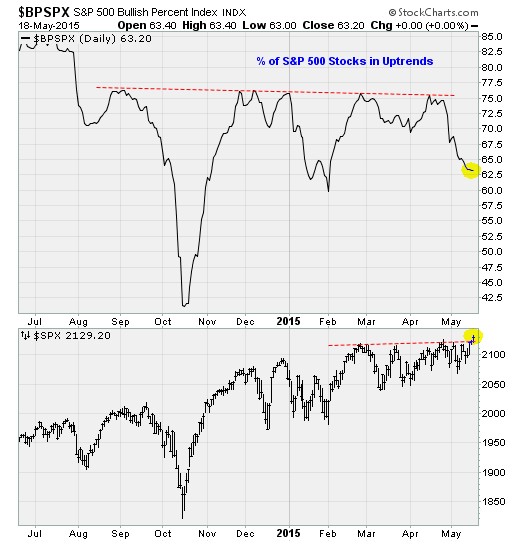Large-cap stocks tried to push to incremental highs again on Tuesday morning, with both the Dow Jones Industrial Average and the S&P 500 trying to build on record closes and threatening to break up and out of multi-month trading ranges. But all's not well beneath the surface.
Everything seems to be going the bulls' way. Weak economic data is expected to keep the Federal Reserve's interest rate hikes at bay until September, or possibly later, based on futures market pricing. First-quarter earnings weren't as bad as expected once the drag from the energy sector is filtered out: Yardeni Research calculates the S&P 500's earnings per share growth rate at 11.5 percent.
And now, commodity prices are bouncing back, with West Texas Intermediate spending most of May flirting with the $60 a barrel level, up from a low of $42.41 back in March.
Related: 7 Quirky Economic Indicators – from Dogs to Guns
But I'm noticing a troublesome lack of technical strength in the move to new highs, suggestive of a lack of conviction. Is this merely a fake out before a move back down?

The chart above shoes that while the S&P 500 has pushed to never-before-seen heights, the move is coming on very narrow breadth. The percentage of components in uptrends is stalled near 63 percent compared to highs near 75 percent in recent months. While nothing its stopping stocks from moving higher anyway, the current move is happening on an awfully small base of support, indicating that the bulls don't find many issues attractive at these levels.
There's more.
Sentiment is hyper bullish. From a contrarian's perspective, that's worrisome. According to Jason Goepfert at SentimenTrader, there are currently three times as many bullish newsletter writers as bearish ones. What's odd is that aside from Monday's rise, stocks really haven't been doing much since last December, when the Dow first challenged the 18,000 level. The combination of newsletter bullishness and narrow price range in stocks has reached levels rarely seen over the past 40 years.
Historically, such a combination has been a headwind for stocks. Three months later, the market's median performance was a decline of 1.1 percent vs. the typical 2 percent rise for such a stretch.
To be sure, this is no normal market environment. Stocks have grown dependent upon the flow of cheap money stimulus from the major central banks, which in turn, has fueled the flow of debt-financed share buybacks. Even if the Fed holds off, as I've discussed in a recent article, the bond market is showing signs of turbulence as inflation expectations drift higher — pushing down long-term Treasury bond prices and pushing up yields.
Related: Bond Market Is Sending the Fed an Important Signal
In fact, through last week, the main high-yield corporate bond ETFs suffered their largest 20-day capital outflows ever.
Maybe stocks can shrug all this off and keep marching higher. But with the S&P 500 not suffering a 10 percent correction since 2012, one wonders if the bulls just don't have the energy for another melt-up rally.
Top Reads from The Fiscal Times:






